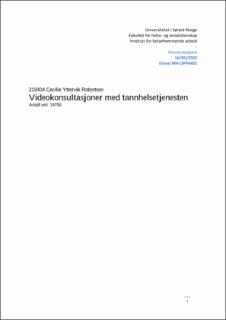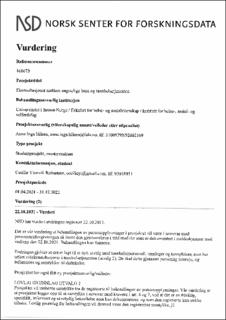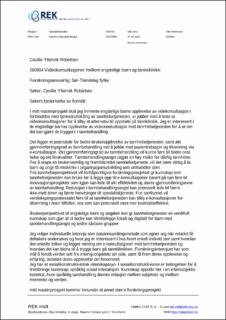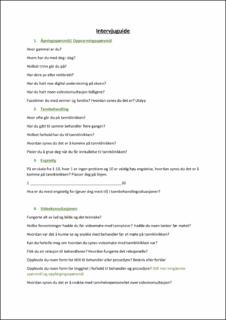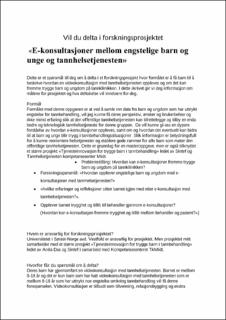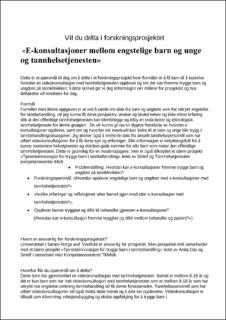| dc.contributor.advisor | Anne Inga Hilsen | |
| dc.contributor.author | Robertsen, Cecilie Yttervik | |
| dc.date.accessioned | 2022-08-11T16:42:51Z | |
| dc.date.issued | 2022 | |
| dc.identifier | no.usn:wiseflow:6592797:50400797 | |
| dc.identifier.uri | https://hdl.handle.net/11250/3011421 | |
| dc.description.abstract | Bakgrunn: Teknologi vil bli en bærebjelke i fremtidens helse- og omsorgstjeneste. Når Covid-19 pandemien rammet verden, oppfordret helsedirektoratet tannhelsetjenesten å bruke digitale tjenester, som videokonsultasjoner, som et ekstra verktøy for å ivareta lovpålagte oppgaver. Spesielt opp mot sårbare grupper. Så mange som 12-20 % av barn og unge har tannbehandlingsangst, og hvis den ikke adresseres kan den videreutvikles til odontofobi.
Formål: Formålet med denne studien er å samle kunnskap om opplevd erfaring med videokonsultasjoner fra både pasienter, deres pårørende og tannhelsepersonell. Dette for å se om videokonsultasjoner kan være en digital bidragsyter med å trygge barn til tannbehandling.
Metode: Dette er en kvalitativ studie og brukte individuelle intervju som metode for datainnsamling. Utvalg har jeg gjort ut fra kriterier som barn, gjennomført videokonsultasjon og engstelig for tannbehandling. Jeg har hatt fire intervju med barn som er engstelige for tannbehandling sammen med deres foresatte. For å belyse tannhelsepersonellets opplevelse og erfaring har jeg hatt tre intervju. Jeg har benyttet kontekstanalyse av (Thagaard, 2018) til å tolke datamaterialet.
Resultater: Pasientdeltakerne opplevde det å få tilbudet om videokonsultasjon som positiv og overraskende. De opplevde å få god og tydelig informasjon og forklaring rettet mot barnet på videokonsultasjonen. De erfarte at det var godt og trygt å sitte hjemme og se tannklinikken fra avstand. De klarte å holde god konsentrasjon og oppmerksomhet, slik at de følte det var lettere å følge med på informasjon gitt over video. Alle pasientdeltakerne gjennomførte sin tannbehandlingssituasjon uten flere tilvenningstimer. Forutsigbarhet og det å vite akkurat hva som skulle skje bidro til at tannbehandlingssituasjonen ble både begripelig og mer håndterbar. De klarte å danne relasjon til tannhelsepersonellet og likte å vite hvem de skulle møte på tannklinikken.
Tannhelsedeltakerne syntes det var interessant, lurt og et nyttig verktøy tannhelsetjenesten manglet. De opplevde noe usikkerhet omkring det tekniske og hva en videokonsultasjon skulle inneholde. De erfarte at barna var mer pratsomme på videokonsultasjon, og at foresatte lot barna være i sentrum mer enn på tannklinikken. De sparte tid da de slapp å sprite av kontoret, de kunne konsentrere seg om relasjonsbygging, informasjon rettet mot barnet fremfor behandling og erfarte at pasientene gjennomførte sin tannhelseutfordring på tannklinikken etter videokonsultasjon uten mer tilvenning.
Konklusjon: Videokonsultasjonene i studien hadde positiv effekt på deltakerne og økte gjennomføringsgrad av tannbehandling. De håndterte tannbehandlingssituasjonene og beskrev at tannhelsepersonell forklarte slik at det ble begripelig for barna. Digitalisering og digitale verktøy er morgendagens tannhelsetjeneste og vil være en viktig bidragsyter til å levere gode og tilpassede tjenester til befolkningen. | |
| dc.description.abstract | Background: Technology will be a mainstay of future health and care services. When the Covid 19-pandemic hit us, the Norwegian Directorate of Health encouraged the dental health care to use digital solutions, such as video consultations, as an extra tool to maintain statutory tasks towards patients. Especially for vulnerable groups. As much as 12-20 % of children have dental fear.
Aim: The aim of this study is collecting knowledge about lived experiences with video consultations in dental care. Experiences by patients, their parents, and dental staff. This to see if video consultations can be a digital contributor to create support and less anxiety for children in dental treatment.
Method: This is a qualitative study where I used individually interview with children and their parents, and dental staff. I have used context analysis by (Thagaard, 2018) to interpret data material.
Results: The patient participants experienced good and clear information and explanation directed towards the children during the video consultations. They experienced that it was good and safe to sit at home and se the dental clinic from a distance, away from sounds, smells and instruments. They managed to keep good concentration and attention, so that they felt it was easier to follow the given information over video. All patient participants completed their dental treatment situation without more habituation hours. Predictability and knowing exactly what was going to happen contributed to the dental treatment situation becoming both understandable and more manageable. They managed to form a relationship with the dental staff and liked to know who to meet when they had an appointment at the dental clinic.
The dental staff thought it was interesting, smart and a useful tool the dental health service lacked. They experienced some technical uncertainty and insecurity about what a video consultation can include. They experienced that the patients were more talkative on video, and that their parents let their children be the center of attention more than on a physical appointment. They saved time as they did not need dental hygiene routine in the office, they could focus on building a relation towards the patients and give information aimed at the child’s level instead focusing on the treatment. They experienced that the patients completed dental treatment after video consultation without further habituation.
Conclusions: The video consultations in the study had a positive effect on the patients and increased the degree of implementation of dental treatment. The patients handled their dental treatment situation better and described that dental staff explained everything so dental treatment was more comprehensible. Digitalization and digital tools are tomorrow’s dental health service and will be an important contributor to delivering good and customized services towards to the population. | |
| dc.language | nob | |
| dc.publisher | University of South-Eastern Norway | |
| dc.title | Videokonsultasjoner med tannhelsetjenesten | |
| dc.type | Master thesis | |
